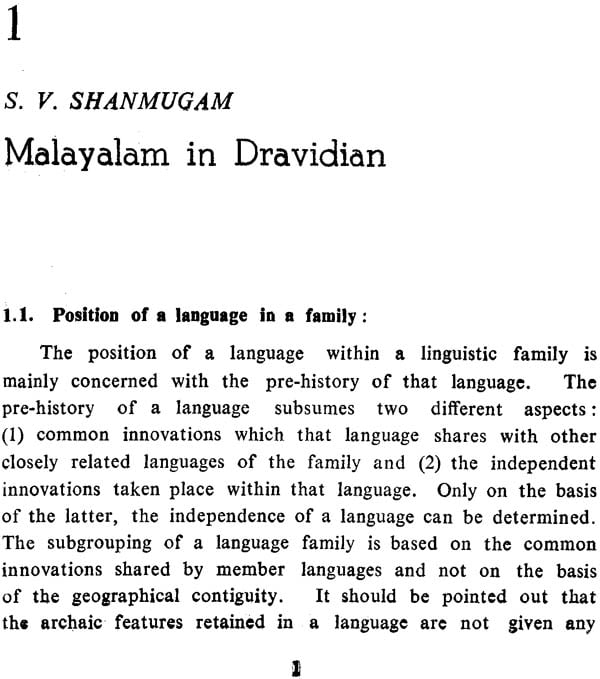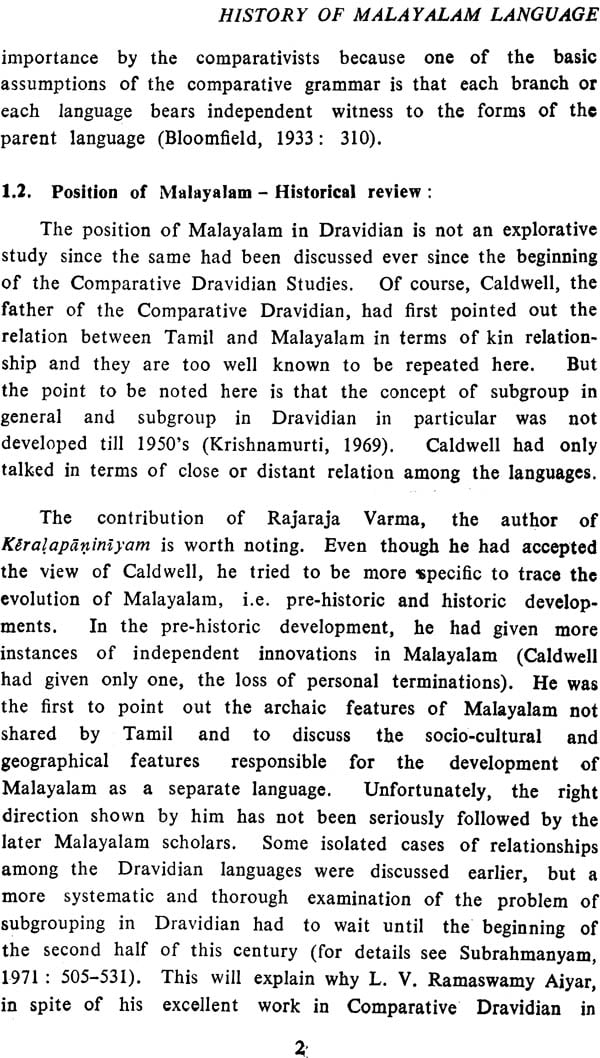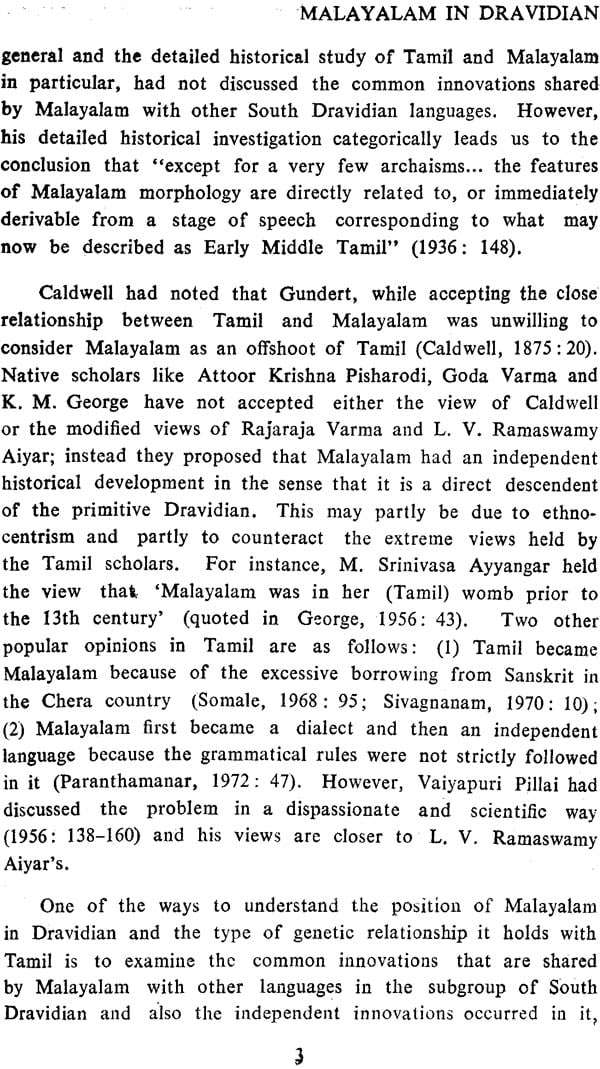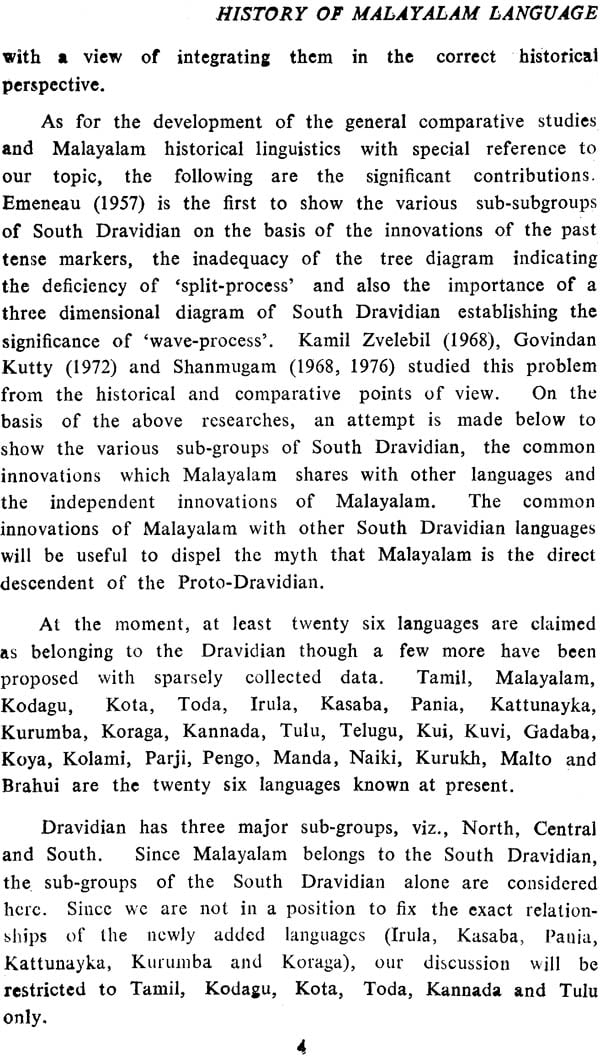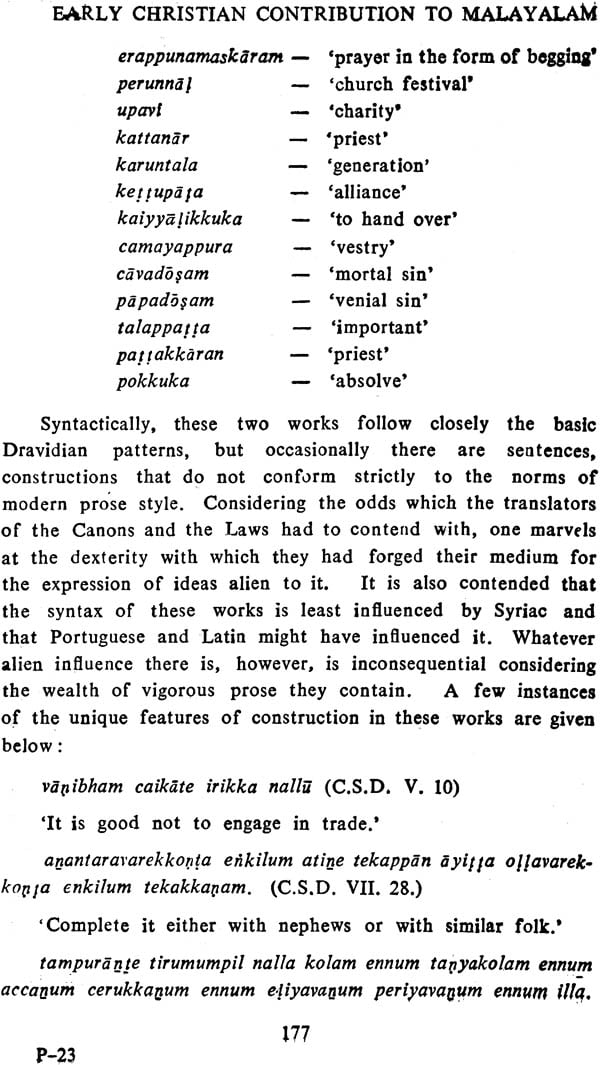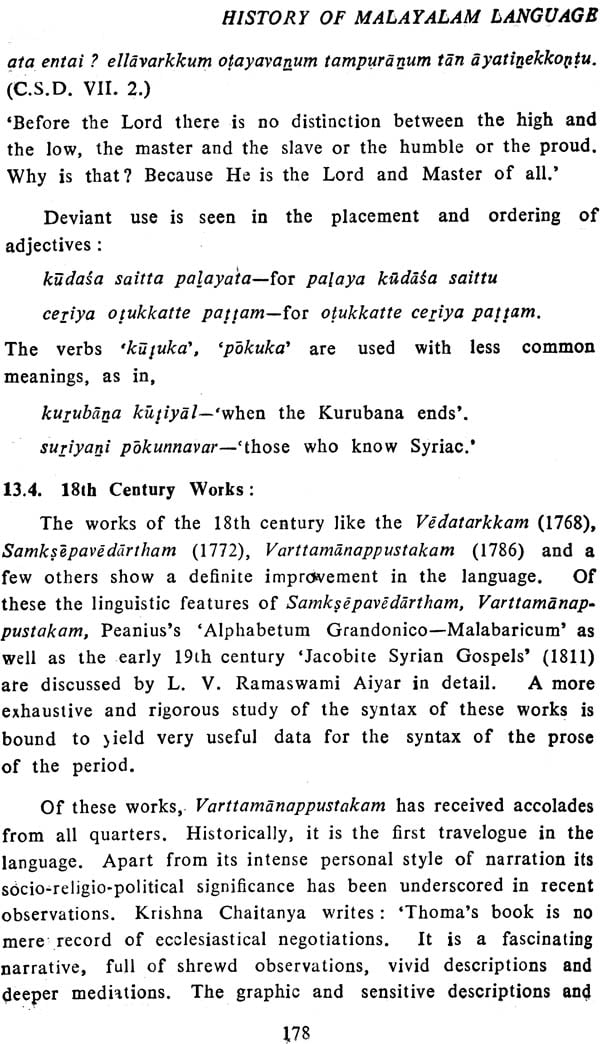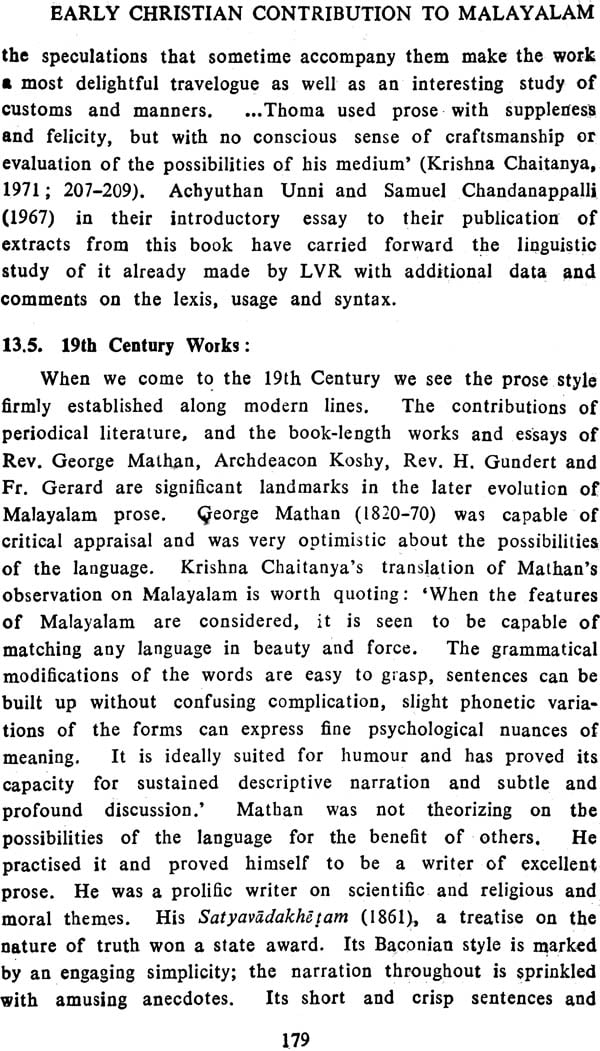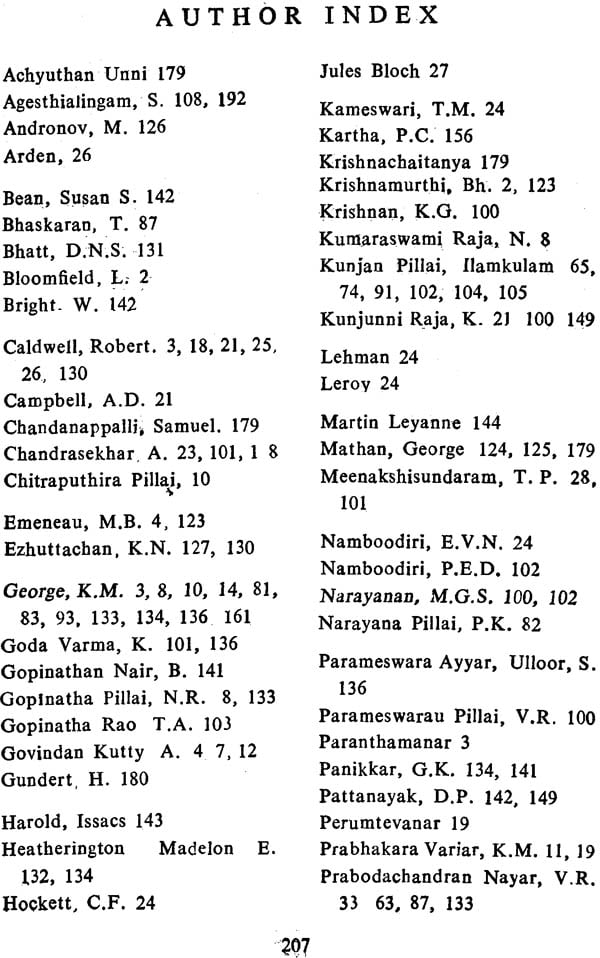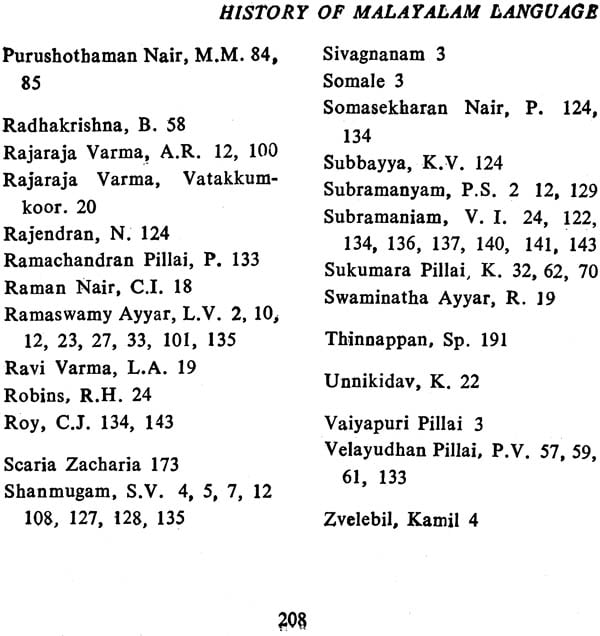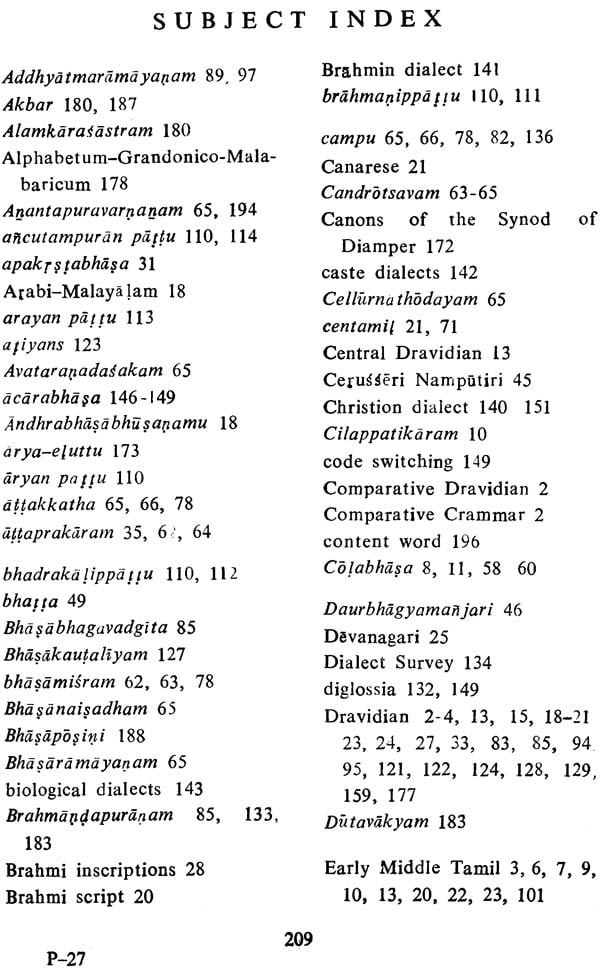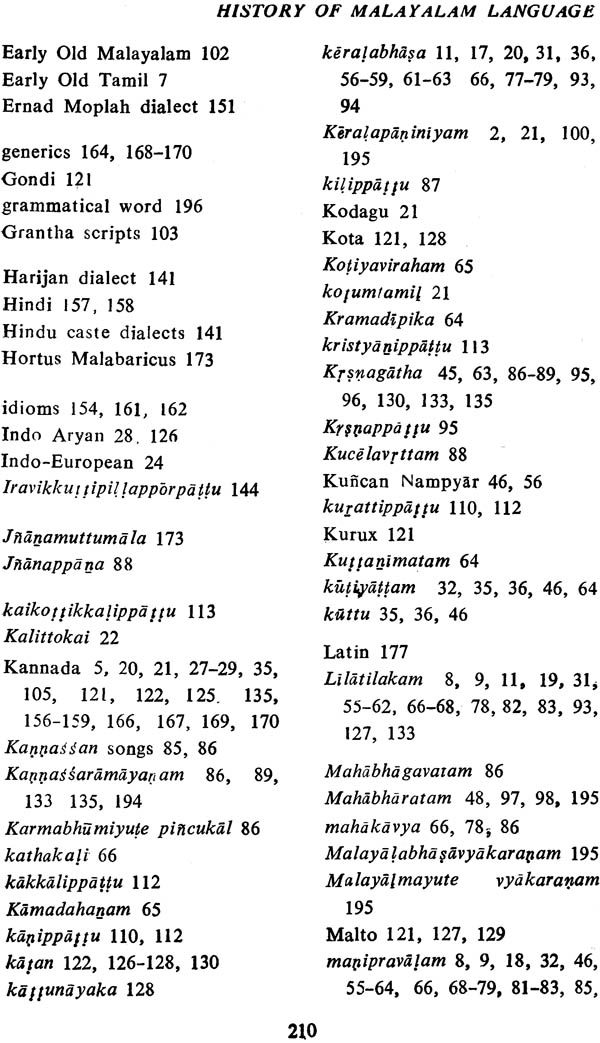
History of Malayalam Language (An Old and Rare Book)
Book Specification
| Item Code: | NAK343 |
| Author: | K.M. Prabhakara Variar |
| Publisher: | UNIVERSITY OF MADRAS |
| Language: | English |
| Edition: | 1985 |
| Pages: | 220 |
| Cover: | Hardcover |
| Other Details | 9.5 inch X 6.5 inch |
| Weight | 360 gm |
Book Description
This volume contains fifteen papers on various aspects of the history of Malayalam language. Prepared by wellknown scholars, the collection presents a comprehensive view of the historical evolution of the language of the westcoast in South India. Subjects like the position of Malayalam in the Dravidian family, the emergence of the westcoast dialect as a separate language, the languages of Pattu and Manipravalam literary movements, the impact of Sanskrit on Malayalam, the linguistic characteristics of Kerala inscriptions and folk-songs, etc are dealt with using the analytic techniques of modern diachronic linguistics. Also included are studies on standardization, sociolinguistic stratification and on proverbs, idioms and place-names. The development of Malayalam Prose is examined in a separate paper and the historical evolution of the auxiliary verb constructions in another.
The collection, though the chronological links are not highlighted, is the first publication which ecompasses almost all the significant stages of the development of the Malayalam language.
The Department of Malayalam, University of Madras organized a five-day seminar on the 'History of Malayalam Language' from 7 to 11 December 1981 with the financial assistance from the University Grants Commission. The present volume contains the revised and edited versions of fifteen papers presented in the seminar which survey the history of the development of Malayalam language in general and certain other more specific aspects of language history in particular.
There are at least three approaches for the reconstruction of the history of a language. (1) Period-based Approach: The justifying assumption for this approach is that the chronological continuance of the history of the language can be recorded only along the time-scale. But it is well-known that historical changes do not take a unidirectional course like a single streamlet; instead, history at every stage consists of myriads of zig-zagging streamlets and rivulets to form into a mighty river. Accordingly, the period-based approach has to take into consideration several heterogenous phenomena at each single stage which is likely to present a cumbersome picture. (2) Genre-based Approach: The justifying assumption for this approach is that the developments of linguistic expressions in genres are not uniform; hence, the examination of language history separately in each genre becomes a prerequisite for the overall reconstruction of the history of the language at a particular period. But, though the details of the history of linguistic features in each genre can be made more explicit, the integration of the co-ordinating factors presents serious problems in this approach. (3) Category- based Approach: The justifying assumption for this approach is that the transformations of each grammatical category in the language along with its varying implication at each stage of its history can be clearly shown by this method. But the tracing of the histories of individual grammatical categories on the basis of the principles of external and internal methods of reconstruction does not by itself help us to formulate the total evolutionary history of the language. Consequently, this approach fails to give us a coherent and interrelated comprehensive picture.
All the three approaches, as we have seen above have their own strengths and weaknesses. Hence, there is no ideal method for the reconstruction of language history. In the present volume most of the papers are prepared from the point of view of the second approach mentioned above. As such, we do not claim that the fifteen papers included here collectively present a chronological, albeit brief, history of the language of Kerala. Nonetheless, since we have for the first time a near-overall view of the history of Malayalam language through successive stages, we hope that the volume will be welcomed as a significant reference work by the students as well as by the scholars at large.
The recorded direct reference to Malayalam language dates back to the fourteenth century Sanskrit work on the manipravala style of diction, Lilatilakam, wherein the anonynous author discusses, with much fumes eminating from it rather than light, the independence of the language of Kerala and its distinctive characteristic which distinguishes the same from its genetically closer member of the Dravidian family the colabhasa (viz. Tamil). The very fact that such a discussion had a relevance to the scholarly circle of those times indicates the fluid state of the Kerala language during the fourteenth century. Significantly, a century after, we have the appearance of Krsnagatha which has rightly been recognized as the first representative poetical work of the developed Malayalam language. The course of the history of the poetic expression since then was smooth with no noteworhty changes along its path. But the language of prose till the middle of the nineteenth century showed an unsteady gait. Thereafter t taking fast strides Malayalam prose underwent far-reaching transformations, the native pedantic style blending with the down-to-earth Early Christian Missionary Prose and subsequently imbibing the subtle nuances of the English prose style.
Since Lilatilakam, and before the appearance of Caldwell's monumental treatise on Dravidian, there were no direct references to the history of the westcoast language in any published work. Caldwell's influence on later-day Malayalam scholars was so marked that subsequent studies were all based on his thesis, either by refuting his 'offshoot theory' or by modifying it or by totally subscribing to the crux with minor reservations about the details. The post-Caldwellian Malayalam studies were fragmentary and scattered. A. R. Rajaraja Varma, L. V. Ramaswamy Ayyar, K. Goda Varma, Ilamkulam Kunjan Pillai, K. M. George, C. L. Antony, P. V. Velayudhan PiIlai and a few others made significant contributions to this field.
The establishemt of a department of linguistics in Annamalai University in the early sixties and another in Kerala University a few years later paved way for fresh investigations on languages as a result of which several descriptive analyses of ancient and medieval literary texts in Malayalam have been produced as Ph.D. dissertations. Only a few of them have come out in print. We have thus descriptive studies on Ramacaritam (there are actually three studies on the language of this ancient Malayalam text, each one differing from the other in methodology and scope), Kannassaramaya krsnagatha, Bharatam (by Tunchat Ezhuthachan) Tullalkrtikal (by Kunchan Nambyar), Anantar uravarnanam and Vasudevastavam (early Manipravla works), Asokavanikankam attaprakaram (a guide for the performance of Kutiyattam writen in manipravata style) besides three critical studies on Lilatilakam and a study of Malayalam inscriptions. All these offer abundant materials for the reconstruction of the early and medieval periods of the development of Malayalam language. Most of these studies are referred to by the authors of the papers included in this volume. Despite all the above partial attempts, no comprehensive history of the language has been written so far. The importance of the present collection of papers, therefore, has to be highlighted as, though lacking connecting links, we have here a fairly near-exhaustive picture of the history of Malayalam language between two covers.
In any collection of this type, we cannot ensure uniformity in respect of methodology, scope and style. The editor of this volume has not interfered with the opinions of the learned authors; his work was confined to exclude certain portions which were obviously repetitions and to effect certain touches for the sake of clarity. It is hoped that the users of this volume would be good enough to send their suggestions for a better presentation of the contents in future editions.
I am grateful to Miss. K. Sreekumari (Ph.D. student, Department of Malayalam) for editorial assistance and to Mr. G. Soundararajan (Superintendent, O.R.I.) for secretarial help.
| Preface | iii-vi | |
| 1 | Malayalam In Dravidian | 1-15 |
| 2 | Split--How And When? | 17-30 |
| 3 | Sanskrit Impact On Malayalam | 31-54 |
| 4 | The Language of Manipravala Literature | 55-79 |
| 5 | Language of The Pattu Literature | 81-89 |
| 6 | Standardization of Poetical Language | 91-98 |
| 7 | The Language of Inscriptions | 99-108 |
| 8 | The Language of Folk Songs | 109-120 |
| 9 | Tribal Languages And Malayalam | 121-130 |
| 10 | Malayalam Dialects | 131-144 |
| 11 | Language Stratification | 145-151 |
| 12 | Proverbs Idioms And Place Names | 153-170 |
| 13 | Early Christian Contribution To Prose | 171-180 |
| 14 | Evolution of Modern Prose | 181-189 |
| 15 | Development of Auxiliary Verbs | 191-197 |
| Bibliography | 199-205 | |
| Author Index | 207-208 | |
| Subject Index | 209-212 |
